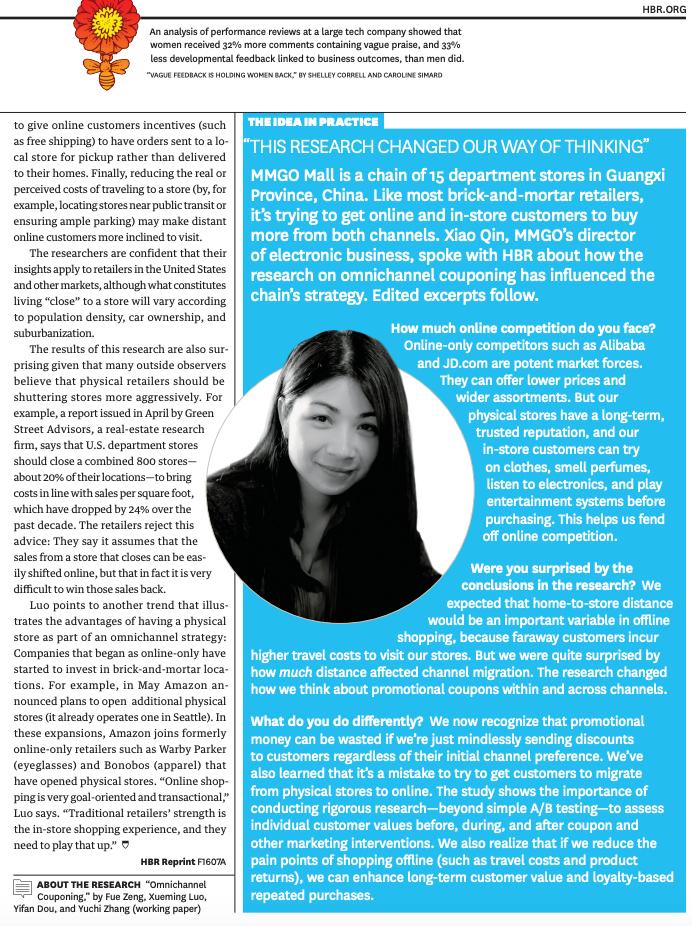Answered step by step
Verified Expert Solution
Question
1 Approved Answer
Why Amazon is opening brick-and-mortar stores (or acquiring Whole Foods). Gathering support from this article indicate why.? Why is it that encouraging online customers to
- Why Amazon is opening brick-and-mortar stores (or acquiring Whole Foods). Gathering support from this article indicate why.?
- Why is it that encouraging online customers to visit a store increased profits while incentivizing in-store customers to shop online decreased profits?


MARKETING HOW TO MAKE THE MOST OF OMNICHANNEL RETAILING Your best bet is to get online customers to visit your stores. ne of the biggest challenges for brick-and-mortar retailers is find- ing a strategy to compete with on- line-only sellers such as Amazon. Although Walmart and JCPenney, for example, have invested substantially in e-commerce op- erations to complement their physical stores, the economics facing these hybrid retailers remain daunting. Both chains announced store closings in 2016. For retailers that operate both stores and websites, the conventional "omnichannel" strategy is to encourage shopping across channels so that customers who shop only in stores will begin also buying online, and vice versa. Promotions and coupons are one way to promote this behavior, and retailers such as Macy's, Bed Bath & Beyond, and Home Depot routinely use them. However, few retailers have closely ex- amined the profitability of such promotions. And they typically pay little attention to a variable that may be particularly important when customers are deciding whether to shop online or in-store: the distance between home and the nearest store. To understand how these variables interact to affect customer behavior and retailer profitability, a research team led by Xueming Luo, a marketing professor at Temple University, worked with a Chinese department store on its coupon strategy. The researchers randomly selected 56,000 members of the store's loyalty program. On the basis of purchase records, they identified 8,692 who shopped exclusively online and 24,804 who shopped only in physical stores. (They dropped the remainder, who already shopped in both channels, from the study.) Some of the 33,496 targeted customers were sent coupons redeemable only online; some were sent coupons good only in physical stores; and some were sent coupons good in either channel. Members of a control group got no coupons at all. Encouraging online customers to visit a store increased profits, but incentivizing in-store customers to shop online decreased them. The researchers then monitored pur- chases over the next week and compared the coupon recipients' behavior-and the effect on the chain's profits, net of coupon costs-with that of the control subjects. For their analysis, they divided the shoppers into two categories according to their proximity to a physical store. The dividing line was five kilometers, a distance that makes sense in a densely populated urban area where many shoppers rely on public transportation. Among customers who lived close to a store, no type of coupon made a significant difference to shopping or profits. For those customers, the researchers concluded, the costs of getting to a store were low, so no added motivation was needed to prompt a trip. Among customers who lived farther away and had previously shopped only on- line, the online coupon generated twice as much profit as among the control group, and the flexible coupon increased profits by 800%. But when distant shoppers who'd previously bought only in stores were given online-only coupons, profits from them fell by 51%. In other words, encouraging online customers to visit a store increased profits, but incentivizing in-store customers to shop online decreased them. This may seem counterintuitive: Most retailers want customers to shop in both channels, in the belief that it shows the cus- tomer has a stronger relationship with and is buying more from them. Driving customers online also helps physical retailers rational- ize the huge investments they've made in IT to support their websites and mobile apps. However, incentivizing a store-to-online shopping migration ignores several key points: Customers who shop in stores tend to buy more, partly because they make more impulse purchases. They're also more will- ing to buy tactile, "experiential" goods such as apparel, shoes, and makeup. And they're less likely to compare prices, because that's harder to do in-store than online. "If custom- ers come to your [physical] stores regularly, you should not encourage them to shop on- line," Luo advises. The more profitable play is to coax online shoppers to come into your stores, where the environment can induce them to spend more. "That's the winning omnichannel strategy," Luo says. How to do that? The research shows. that coupons redeemable only in stores and targeting previously online-only shoppers who live some distance away can work well. Another strategy, which Walmart and some other retailers are already implementing, is For more about retail and online strategies, see these articles on HBR.org: "Competing on Customer Journeys," by David C. Edelman and Marc Singer: "Digital-Physical Mashups," by Darrell K. Rigby; and "The Future of Shopping." by Darrell K. Rigby.
Step by Step Solution
There are 3 Steps involved in it
Step: 1
1 Amazon Opening BrickandMortar Stores or Acquiring Whole Foods Reasons for Amazons Physical Stores ...
Get Instant Access to Expert-Tailored Solutions
See step-by-step solutions with expert insights and AI powered tools for academic success
Step: 2

Step: 3

Ace Your Homework with AI
Get the answers you need in no time with our AI-driven, step-by-step assistance
Get Started


